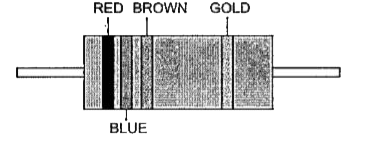The third band in colour coded resistance represents
Third digit of resistance
Number of zeros after two digits
Number of zeros after one digit
Percentage of tolerence of resistance
The correct Answer is:B
To solve the question regarding what the third band in color-coded resistance represents, we will follow these steps:
1. Understand Color Code Representation:
- Resistors have color bands that indicate their resistance value. The first two bands represent significant digits, the third band represents the multiplier, and the fourth band represents tolerance.
2. Identify the Role of the Third Band:
- The third band in the color code is specifically used to indicate the multiplier. This means it tells us how many zeros to add to the significant digits represented by the first two bands.
3. Express Resistance Value:
- The resistance can be expressed as:
R=(AB)×10C±T
Where:
- AB are the significant digits from the first two bands.
- C is the value represented by the third band (which indicates the power of ten).
- T is the tolerance indicated by the fourth band.
4. Example for Clarity:
- If the first two bands are brown (1) and red (2), the resistance value starts as 12. If the third band is orange (which represents 103), the resistance value becomes:
12×103=12000Ω
- This shows that the third band indicates how many zeros to add after the significant digits.
5. Conclusion:
- Therefore, the third band in a color-coded resistor represents the multiplier, specifically the number of zeros to be added after the first two significant digits.
Final Answer:
The third band in color-coded resistance represents the multiplier (number of zeros after the significant digits).
- Resistors have color bands that indicate their resistance value. The first two bands represent significant digits, the third band represents the multiplier, and the fourth band represents tolerance.
- The third band in the color code is specifically used to indicate the multiplier. This means it tells us how many zeros to add to the significant digits represented by the first two bands.
- The resistance can be expressed as:
R=(AB)×10C±T
Where:
- AB are the significant digits from the first two bands.
- C is the value represented by the third band (which indicates the power of ten).
- T is the tolerance indicated by the fourth band.
- If the first two bands are brown (1) and red (2), the resistance value starts as 12. If the third band is orange (which represents 103), the resistance value becomes:
12×103=12000Ω
- This shows that the third band indicates how many zeros to add after the significant digits.
- Therefore, the third band in a color-coded resistor represents the multiplier, specifically the number of zeros to be added after the first two significant digits.
The third band in color-coded resistance represents the multiplier (number of zeros after the significant digits).
Topper's Solved these Questions
- APPENDICES ( REVISION EXERCISE )Book:AAKASH SERIESChapter:APPENDICES ( REVISION EXERCISE )Exercise:REVISION EXERCISE (MOVING CHANGES & MEGNETISM)
Explore 95 Videos
- APPENDICES ( REVISION EXERCISE )Book:AAKASH SERIESChapter:APPENDICES ( REVISION EXERCISE )Exercise:REVISION EXERCISE (MAGNETISM AND MATTER )
Explore 52 Videos
- APPENDICES ( REVISION EXERCISE )Book:AAKASH SERIESChapter:APPENDICES ( REVISION EXERCISE )Exercise:REVISION EXERCISE (ELECTRIC POTENTIAL & CAPACITANCE )
Explore 143 Videos
- ALTERNATING CURRENTBook:AAKASH SERIESChapter:ALTERNATING CURRENTExercise:EXERCISE - III
Explore 24 Videos
- APPENDICES (REVISION EXERCISE)Book:AAKASH SERIESChapter:APPENDICES (REVISION EXERCISE)Exercise:LAW OF MOTION
Explore 128 Videos
Similar Questions
A constant potential difference is applied across a resistance. Consider variation of resistance with temperature. Which graph represents best the variation of power produced in resistance versus resistance?
View SolutionThe figure below shows a colour-coded resistor. The resistance of this resistor is:

View Solution
Knowledge Check
I band has
Aonly actin filamentsBonly myosin filamentsCboth actin and myosin filamentsDone sarcomereAssertion (A): The Indian National Congress was not represented in the Third Round Table Conference.
Reason (R): Congress had boycotted it.ABoth A and R are true and R is the correct explanation of A.BBoth A and Rare true but R is not the correct explanation of A.CA is true but R is false.DA is false but R is true.A carbon resistor has coloured bands as shown in figure below. The resistance of the resistor is :
 A26Ω±10%B26Ω±5%C260Ω±5%D260Ω±10%
A26Ω±10%B26Ω±5%C260Ω±5%D260Ω±10%
The color code of a resistance is given below:

The value of resistance and tolerance , respectively are
View SolutionThe band of seven colours obtained on a screen when white light passes through a prism is called spectrum. ____
View SolutionA 200Ω resistor has a certain color code. If one replaces the red color by green in the code, the new resistance will be:
View SolutionIf L,C and R represent inductance, capacitance and resistance respectively, then which of the following does not represent dimensions of frequency
View SolutionIn a carbon resistor the last band colour is missing. Its tolerance is
View Solution

